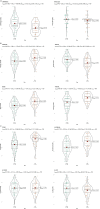Sex-related perception of body image, attitude toward food, and nutritional status of university students, and their relationship with physical activity level
- PMID: 40330304
- PMCID: PMC12053168
- DOI: 10.3389/fpsyg.2025.1567566
Sex-related perception of body image, attitude toward food, and nutritional status of university students, and their relationship with physical activity level
Abstract
University life is a critical period for acquiring and consolidating healthy habits. This study examined the influence of sex on the body image perception, attitude toward food, nutritional status, and lifestyle habits of university students. This descriptive observational study included 163 university students from a program of Health Sciences. The data were collected with digitally distributed, self-administered questionnaires. Instruments such as the International Physical Activity Questionnaire were used to measure physical activity, the Eating Attitudes Test-26 to assess attitudes toward food, the Multidimensional Body Self Relations Questionnaire and Gardner's assessment for body image perception, and the Prevención con Dieta Mediterránea for adherence to the Mediterranean diet. Body composition was evaluated with an InBody 770 device. Most of the values found were within the appropriate range and not significant in practice, except in the Gardner test for women, where relevant values were found. Female participants demonstrated greater dissatisfaction with their body image and higher EAT-26 scores, indicating an increased risk for eating disorders. Male participants exhibited higher body mass index and physical activity levels. No significant differences were observed in adherence to the Mediterranean diet between the sexes. Correlations between the variables revealed that body dissatisfaction was associated with a higher percentage of body fat and visceral fat area in both sexes. Gender differences in body image perception and attitude toward food underscore the need for sex-specific interventions. Promoting a positive body image perception and healthy eating habits is essential for improving the physical and mental health of university students. Educational programs should consider these differences and emphasize the promotion of physical activity and adherence to balanced diets.
Keywords: attitude toward food; body image; nutritional status; physical activity; university student.
Copyright © 2025 Ruiz-Bravo, García-Merino, Rodríguez-Rodríguez, Laiz and Díaz Ureña.
Conflict of interest statement
The authors declare that the research was conducted in the absence of any commercial or financial relationships that could be construed as a potential conflict of interest.
Figures



Similar articles
-
Overlap of orthorexia, eating attitude and psychological distress in some Italian and Spanish university students.World J Psychiatry. 2022 Oct 19;12(10):1298-1312. doi: 10.5498/wjp.v12.i10.1298. eCollection 2022 Oct 19. World J Psychiatry. 2022. PMID: 36389086 Free PMC article.
-
Recreational Physical Activity and the Mediterranean Diet: Their Effects on Obesity-Related Body Image Dissatisfaction and Eating Disorders.Healthcare (Basel). 2024 Aug 8;12(16):1579. doi: 10.3390/healthcare12161579. Healthcare (Basel). 2024. PMID: 39201138 Free PMC article.
-
Body image and weight perceptions in relation to actual measurements by means of a new index and level of physical activity in Italian university students.J Transl Med. 2014 Feb 11;12:42. doi: 10.1186/1479-5876-12-42. J Transl Med. 2014. PMID: 24512483 Free PMC article.
-
Assessment of weight status, dietary habits and beliefs, physical activity, and nutritional knowledge among university students.Perspect Public Health. 2016 Jul;136(4):231-44. doi: 10.1177/1757913915609945. Epub 2015 Oct 16. Perspect Public Health. 2016. PMID: 26475773 Review.
-
[Simple obesity in children. A study on the role of nutritional factors].Med Wieku Rozwoj. 2006 Jan-Mar;10(1):3-191. Med Wieku Rozwoj. 2006. PMID: 16733288 Review. Polish.
Cited by
-
Physical Activity and Psychonutritional Correlates of Eating Disorder Risk in Female Health Science Students.Healthcare (Basel). 2025 Jul 11;13(14):1679. doi: 10.3390/healthcare13141679. Healthcare (Basel). 2025. PMID: 40724704 Free PMC article.
References
-
- Alba S. S., Lluna A. G. (2019). Hábitos saludables en universitarios de ciencias de la salud y de otras ramas de conocimiento: Un estudio comparativo. Rev. Esp. Nutr. Hum. Diet. 23, 271–282. doi: 10.14306/renhyd.23.4.762 - DOI
-
- Barrios R. D. (2025). Efecto Del Sesgo de Peso Internalizado En La Imagen Corporal, Las Conductas Alimentarias de Riesgo y El Control de La Imagen Corporal En Fotografías En Adolescentes. Monterrey: Universidad Autónoma de Nuevo León.
LinkOut - more resources
Full Text Sources

